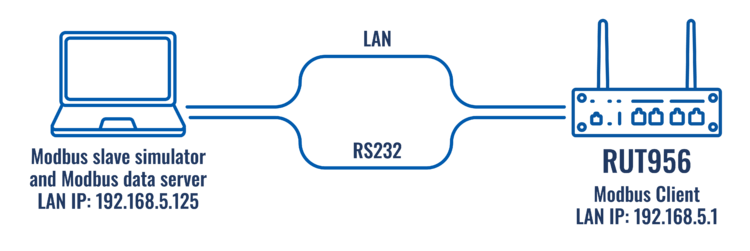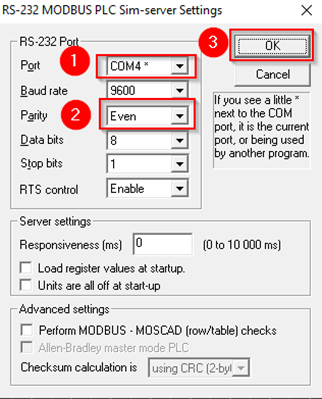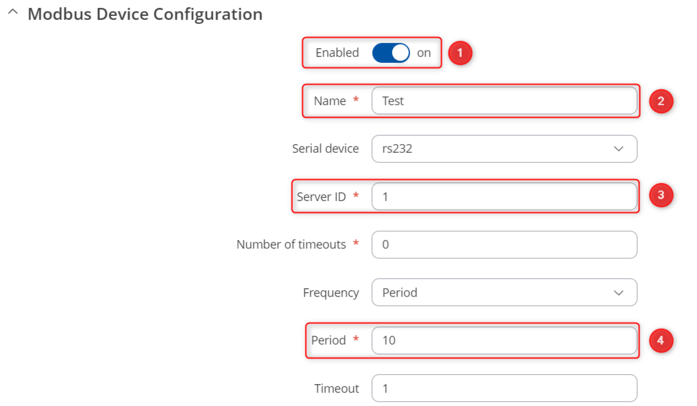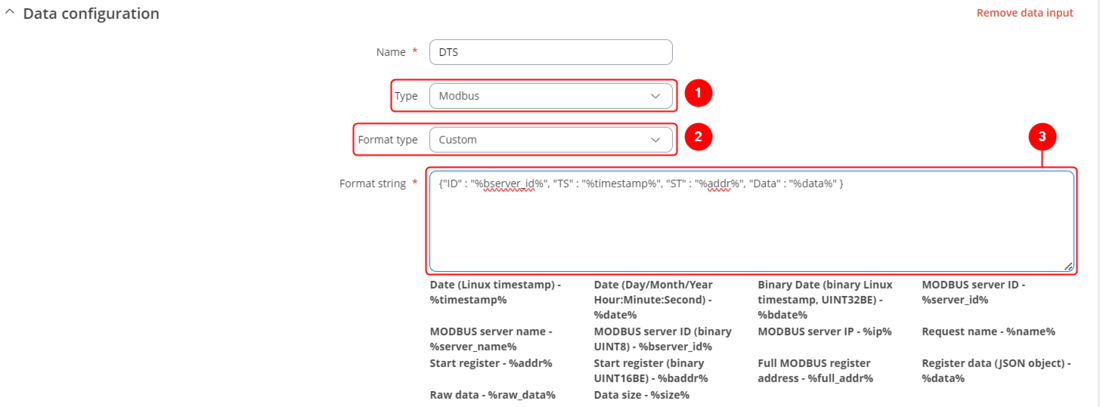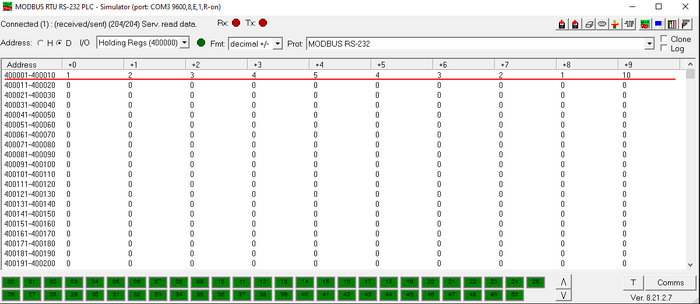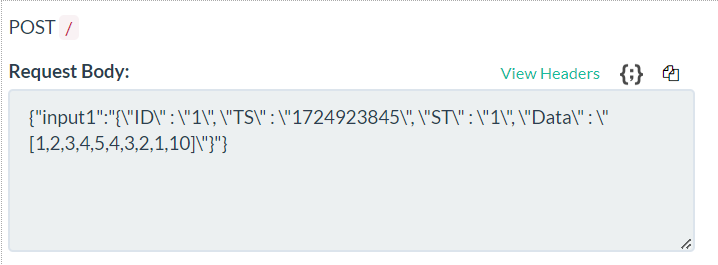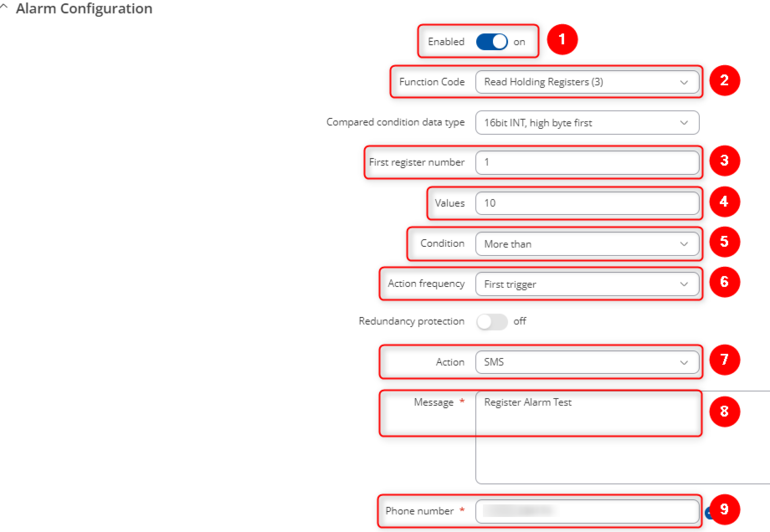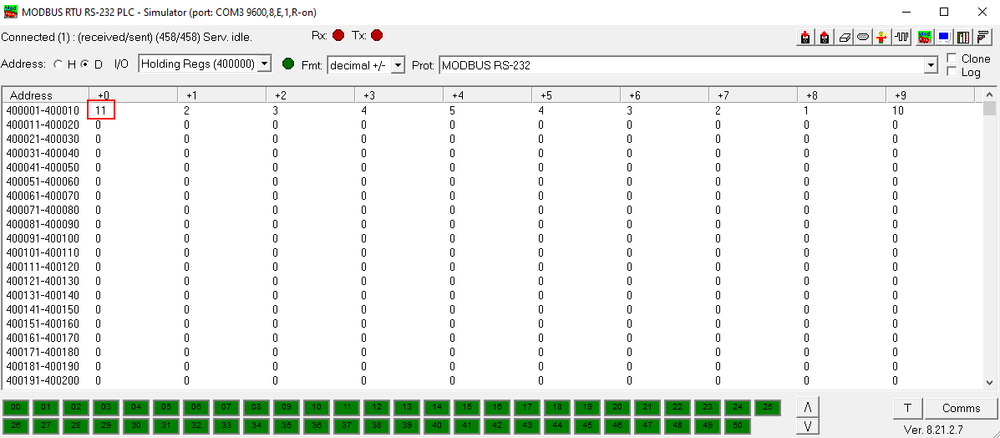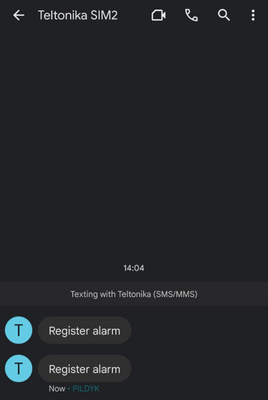Template:Networking manual Modbus serial RutOS: Difference between revisions
| (29 intermediate revisions by the same user not shown) | |||
| Line 16: | Line 16: | ||
*One device with RS232 Serial port; | *One device with RS232 Serial port; | ||
*Windows 10/11 OS computer; | *Windows 10/11 OS computer; | ||
* | *[https://beeceptor.com/ Beeceptor] account and created Mock server; | ||
*ModRSsim application; | |||
*RS232 to USB cable. | *RS232 to USB cable. | ||
==Topology== | ==Topology== | ||
[[File: | [[File:Networking rut955 configuration modbus serial topology 2 v2.png|border|class=tlt-border|750x700px]] | ||
{{Template:Networking install Modbus serial RutOS}} | {{Template:Networking install Modbus serial RutOS}} | ||
==Configuring Modbus | ==Configuring Modbus Serial server device== | ||
In this example we are going to be using our Windows 10/11 OS computer as a slave. To do so you will need to install '''modRSsim''' application, which you can download [https://sourceforge.net/projects/modrssim2/ here]. | In this example we are going to be using our Windows 10/11 OS computer as a slave. To do so you will need to install '''modRSsim''' application, which you can download [https://sourceforge.net/projects/modrssim2/ here]. | ||
When you are done with that, open the app and apply the following configuration. | When you are done with that, open the app and apply the following configuration. | ||
<table class="nd-othertables_2"> | |||
<tr> | |||
<th width=330; style="border-bottom: 1px solid white;></th> | |||
<th width=800; style="border-bottom: 1px solid white"; rowspan=2>[[File:Networking_rut955_configuration_modbus_serial_1_v1.png|border|class=tlt-border|right]]</th> | |||
</tr> | |||
<tr> | |||
<td style="border-bottom: 4px solid white> | |||
# Select '''Protocol''' (MODBUS RS-232). | # Select '''Protocol''' (MODBUS RS-232). | ||
# Click '''Setup the communication Serial or TCP/IP port'''. | # Click '''Setup the communication Serial or TCP/IP port'''. | ||
</td> | |||
</tr> | |||
</table> | |||
---- | ---- | ||
<table class="nd-othertables_2"> | |||
<tr> | |||
<th width=330; style="border-bottom: 1px solid white;></th> | |||
<th width=800; style="border-bottom: 1px solid white"; rowspan=2>[[File:Networking_rut955_configuration_modbus_serial_2_v1.png|border|class=tlt-border|center]]</th> | |||
</tr> | |||
<tr> | |||
<td style="border-bottom: 4px solid white> | |||
# Select the '''Port''' which you connected RS232 cable to (to find which port you are using go to Windows search bar and write '''Device Manager''' then select '''Ports''' and see which one you are using). | # Select the '''Port''' which you connected RS232 cable to (to find which port you are using go to Windows search bar and write '''Device Manager''' then select '''Ports''' and see which one you are using). | ||
# Select '''Parity''' (Even). | # Select '''Parity''' (Even). | ||
# Click '''OK'''. | # Click '''OK'''. | ||
</td> | |||
</tr> | |||
</table> | |||
==Configuring Modbus serial master== | ==Configuring Modbus serial master== | ||
| Line 82: | Line 101: | ||
</tr> | </tr> | ||
</table> | </table> | ||
[[File:Modbus_Serial_RUT955_3.png|border|class=tlt-border|1100x400px]] | [[File:Modbus_Serial_RUT955_3-1.png|border|class=tlt-border|1100x400px]] | ||
[[File:Modbus Serial RUT955 4.png|border | [[File:Modbus Serial RUT955 4.png|border|class=tlt-border|850x280px]] | ||
==Modbus data to server== | ==Modbus data to server== | ||
| Line 90: | Line 109: | ||
---- | ---- | ||
In order to test the functionality, you will need to set up a server | In order to test the functionality, you will need to set up a server. | ||
There are many ways how you can create a server to which Modbus will send data to. In this example we are going to be using | There are many ways how you can create a server to which Modbus will send data to. In this example we are going to be using a Beeceptor's Mock server. If you don't have a Beeceptor account yet – create it or login via Google account. | ||
[[File: | <table class="nd-othertables_2"> | ||
<tr> | |||
# | <th width=300; style="border-bottom: 1px solid white;></th> | ||
# | <th width=800; style="border-bottom: 1px solid white"; rowspan=2>[[File:BeeceptorServer.png|border|class=tlt-border|right]]</th> | ||
</tr> | |||
<tr> | |||
<td style="border-bottom: 4px solid white> | |||
# Specify your desired mock server's '''URL'''. | |||
# Press on '''Create Mock Server'''. | |||
</td> | |||
</tr> | |||
</table> | |||
And that is it, now you will be able to see the data coming from Modbus | And that is it, now you will be able to see the data coming from Modbus to your created Beeceptor's server. | ||
===RUT Modbus data to server configuration=== | ===RUT Modbus data to server configuration=== | ||
---- | ---- | ||
In order to setup your router to send Modbus data to server you will need to navigate to '''Services | In order to setup your router to send Modbus data to server you will need to navigate to '''Services → Data to Server''', create a '''"New collectiom name"''' and press '''ADD''' to add a new instance. | ||
#Select '''Type: Modbus''' | #Select '''Type: Modbus'''; | ||
#Select '''Format Type: Custom''' | #Select '''Format Type: Custom'''; | ||
#Enter desired '''format string''' | #Enter desired '''format string'''; | ||
# | #Leave other parameterms as it is and click on [[File:Next Collection.png|150x35px]] icon; | ||
#In the '''Collection configuration''' window leave the settings as default and click on [[File:Next Server.png|180x35px]] button; | |||
#In the '''Server configuration''' window select '''Type: HTTP'''; | |||
#Enter '''Server address''' | #Enter '''Server address'''; | ||
#Click | #Click [[File:Networking save apply button fw76 v1.png|100x35px]]; | ||
[[File:Modbus Serial Data1.png|border|class=tlt-border|1100x539px]] | |||
[[File:Modbus Serial Data2.png|border|class=tlt-border|1000x250px]] | |||
===Receiving data=== | ===Receiving data=== | ||
---- | ---- | ||
Open Beeceptor's window again, and after some time you should start receiving Modbus Data messages. | |||
[[File:BeeceptorData.png|border|class=tlt-border|]] | |||
Try to change some data in the Modbus Serial server simulator (ModRSsim). | |||
Try to change some data in the Modbus | |||
[[File:Modbus serial rut955 10.png|border|class=tlt-border|700x700px]] | [[File:Modbus serial rut955 10.png|border|class=tlt-border|700x700px]] | ||
| Line 137: | Line 155: | ||
Received data should change. | Received data should change. | ||
[[File: | [[File:BeeceptorData1.png|border|class=tlt-border|]] | ||
== | ==Server alarms== | ||
In order to setup the following configuration SIM card is required. | In order to setup the following configuration SIM card is required. | ||
Go back to '''Services | Go back to '''Services → Modbus → Modbus Serial Client''' and press [[File:Networking edit button fw76 v1.png]] button on the previously created '''Modbus''' server '''Device''' instance or create a new one. In the opened window scroll down to the bottom and in '''Alarms Configuration''' section press [[File:Add Button.png|60x90px]]. | ||
In Alarm Configuration apply the following changes: | |||
<table class="nd-othertables_2"> | |||
<tr> | |||
<th width=320; style="border-bottom: 1px solid white;></th> | |||
<th width=800; style="border-bottom: 1px solid white"; rowspan=2>[[File:Modbus Serial RUT955 10-1.png|border|class=tlt-border|770x570px|right]]</th> | |||
</tr> | |||
<tr> | |||
<td style="border-bottom: 4px solid white> | |||
# '''Enable''' instance. | # '''Enable''' instance. | ||
# Select '''Function''' (Read Holding Registers). | # Select '''Function''' (Read Holding Registers). | ||
| Line 160: | Line 181: | ||
# Create '''Message''' (type anything you want to receive). | # Create '''Message''' (type anything you want to receive). | ||
# Write '''Phone number''' (the number you want to receive the messages to). | # Write '''Phone number''' (the number you want to receive the messages to). | ||
# Press | # Press [[File:Networking save apply button fw76 v1.png|100x35px]] button. | ||
</td> | |||
</tr> | |||
</table> | |||
Now go back to '''Modbus | Now go back to '''Modbus server simulator''' and edit this window: | ||
[[File:Modbus serial rut955 14.png|border|class=tlt-border| | [[File:Modbus serial rut955 14.png|border|class=tlt-border|1000x700px]] | ||
Change the value to anything below 10, you should not receive messages. Then change the value to anything above 10, you should start receiving messages. | Change the value to anything below 10, you should not receive messages. Then change the value to anything above 10, you should start receiving messages. | ||
[[File:Modbus serial rut955 15.png|border|class=tlt-border|400x400px]] | [[File:Modbus serial rut955 15.png|border|class=tlt-border|400x400px]] | ||
Latest revision as of 11:57, 29 August 2024
Summary
Modbus is a serial communications protocol originally published by Modicon (now Schneider Electric) in 1979 for use with its programmable logic controllers (PLCs). Modbus has become a de facto standard communication protocol and is now a commonly available means of connecting industrial electronic devices. The main reasons for the use of Modbus in the industrial environment are:
- developed with industrial applications in mind;
- openly published and royalty-free;
- easy to deploy and maintain;
- moves raw bits or words without placing many restrictions on vendors.
Modbus enables communication among many devices connected to the same network, for example, a system that measures temperature and humidity and communicates the results to a computer. Modbus is often used to connect a supervisory computer with a remote terminal unit (RTU) in supervisory control and data acquisition (SCADA) systems. Many of the data types are named from its use in driving relays: a single-bit physical output is called a coil, and a single-bit physical input is called a discrete input or a contact.
This article provides a brief example on how to use Modbus serial to monitor a slave device, send data to server and how to configure slave alarms. To find more information about this feature visit RUT955 Modbus page.
Prerequisites
- One device with RS232 Serial port;
- Windows 10/11 OS computer;
- Beeceptor account and created Mock server;
- ModRSsim application;
- RS232 to USB cable.
Topology
Installation
From FW version of RUT9_R_00.07.05 and newer Modbus Serial Client package is installed by default. To install it on older FW versions open device's WebUI, navigate to Services → Package manager → Packages and search for Modbus Serial Master and press + icon to install. After installation you should see a status Installed on this package.
Configuring Modbus Serial server device
In this example we are going to be using our Windows 10/11 OS computer as a slave. To do so you will need to install modRSsim application, which you can download here.
When you are done with that, open the app and apply the following configuration.
 |
|
|---|---|
|
Configuring Modbus serial master
Open router’s WebUI, navigate to Services → Modbus → Modbus Serial Client and in Serial Device configuratio section add new instance by entering a name, selecting rs232 and pressing ![]() button. In the newly opened Device Configuration window configure everything as follows:
button. In the newly opened Device Configuration window configure everything as follows:
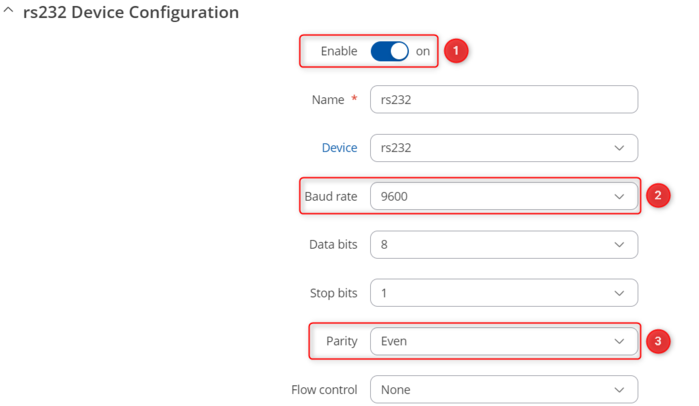 |
|
|---|---|
Now in Modbus Devices section create RS232 slave by writing a new instance name, selecting rs232 and pressing ![]() button. In the new window apply the following configuration:
button. In the new window apply the following configuration:
Modbus data to server
Creating server
In order to test the functionality, you will need to set up a server.
There are many ways how you can create a server to which Modbus will send data to. In this example we are going to be using a Beeceptor's Mock server. If you don't have a Beeceptor account yet – create it or login via Google account.
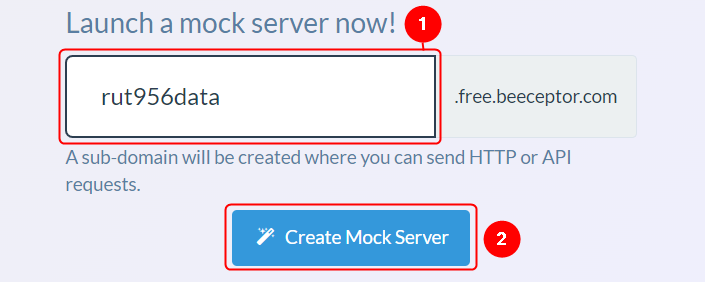 |
|
|---|---|
|
And that is it, now you will be able to see the data coming from Modbus to your created Beeceptor's server.
RUT Modbus data to server configuration
In order to setup your router to send Modbus data to server you will need to navigate to Services → Data to Server, create a "New collectiom name" and press ADD to add a new instance.
- Select Type: Modbus;
- Select Format Type: Custom;
- Enter desired format string;
- Leave other parameterms as it is and click on
 icon;
icon; - In the Collection configuration window leave the settings as default and click on
 button;
button; - In the Server configuration window select Type: HTTP;
- Enter Server address;
- Click
 ;
;
Receiving data
Open Beeceptor's window again, and after some time you should start receiving Modbus Data messages.
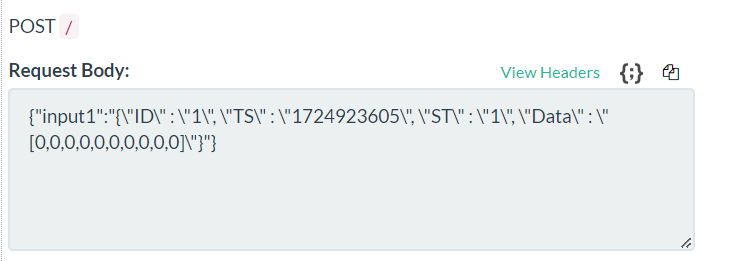
Try to change some data in the Modbus Serial server simulator (ModRSsim).
Received data should change.
Server alarms
In order to setup the following configuration SIM card is required.
Go back to Services → Modbus → Modbus Serial Client and press ![]() button on the previously created Modbus server Device instance or create a new one. In the opened window scroll down to the bottom and in Alarms Configuration section press
button on the previously created Modbus server Device instance or create a new one. In the opened window scroll down to the bottom and in Alarms Configuration section press ![]() .
.
In Alarm Configuration apply the following changes:
Now go back to Modbus server simulator and edit this window:
Change the value to anything below 10, you should not receive messages. Then change the value to anything above 10, you should start receiving messages.

